Curious about playing the flute? Flute For Beginners offers the ideal introduction!
Picture yourself playing beautiful melodies and making music with just your breath. The flute is a magical instrument that’s easy to start but has excellent potential.
In this article, I’ll walk you through each step, from picking the right flute to making your first sound. We’ll also look at the basic techniques and tips so you can start this musical journey confidently.
Don’t worry if you’re new to this; by the end, you’ll be playing your first notes and on your way to becoming a flute player. Let’s get started!
Origins of the flute

From baroque times onwards, flutes were made out of wood and only had a few keys. This limited how many notes this type of flute could play, and made it difficult to play well in tune. Players involved in historical performance still play copies of these instruments, and they are called traverso or baroque flutes.

In the 19th century, Theobold Boehm revolutionized the design of the flute by inventing a new fingering system which is still used today by flute manufacturers.
If you like a challenge then it’s worth checking out his studies that he wrote to show off his new flute. They are fantastic and are standard repertoire for a budding flutist!
Composers have used flutes as solo instruments and for different music groups for hundreds of years and they are still used in the modern symphony orchestra today, and certainly aren’t limited to one music genre.
Why not listen to some of my favorite pieces for flute to inspire your practice?




Types of flute
A flute is a popular wind instrument for beginners.
You play it by blowing across the embouchure hole and covering different finger holes to make various notes. Playing the flute can be a fun and rewarding experience for English-speaking beginners.
But before you start, let’s check out the different types of flutes. Flutes come in various shapes and sizes, so you have a great choice of instruments. The most common types of flutes are:
- Piccolo
- Concert Flute
- Alto Flute
- Bass Flute
Concert Flute
The most common member of the flute family is the concert flute. It has a range from middle C to 3 octaves above this. This flute comes with either a straight headjoint or a curved headjoint for flutists with smaller hands.
These flutes are most commonly made from metal, either silver or silver plated. You can also buy flutes made from gold and platinum if you want to buy a professional model.
Everytime I hear a flute playing in a live orchestra – its sparkling notes cut through the air and added a magical touch to the entire performance. It was truly a breathtaking experience that made me appreciate the unique and beautiful sound of this instrument.
The Yamaha YFL212 flute is one of my favourites and it feels incredibly lightweight and comfortable to hold, making it easy to play for extended periods without fatigue.
Matched with other flutes, the YFL212 stands out for its precise intonation and smooth key action, providing a more consistent and enjoyable playing experience.
However, the YFL212 may be slightly more expensive than some entry-level flutes. Nevertheless, its exceptional build quality, reliable performance, and excellent resale value make it a worthwhile investment for any aspiring flutist.
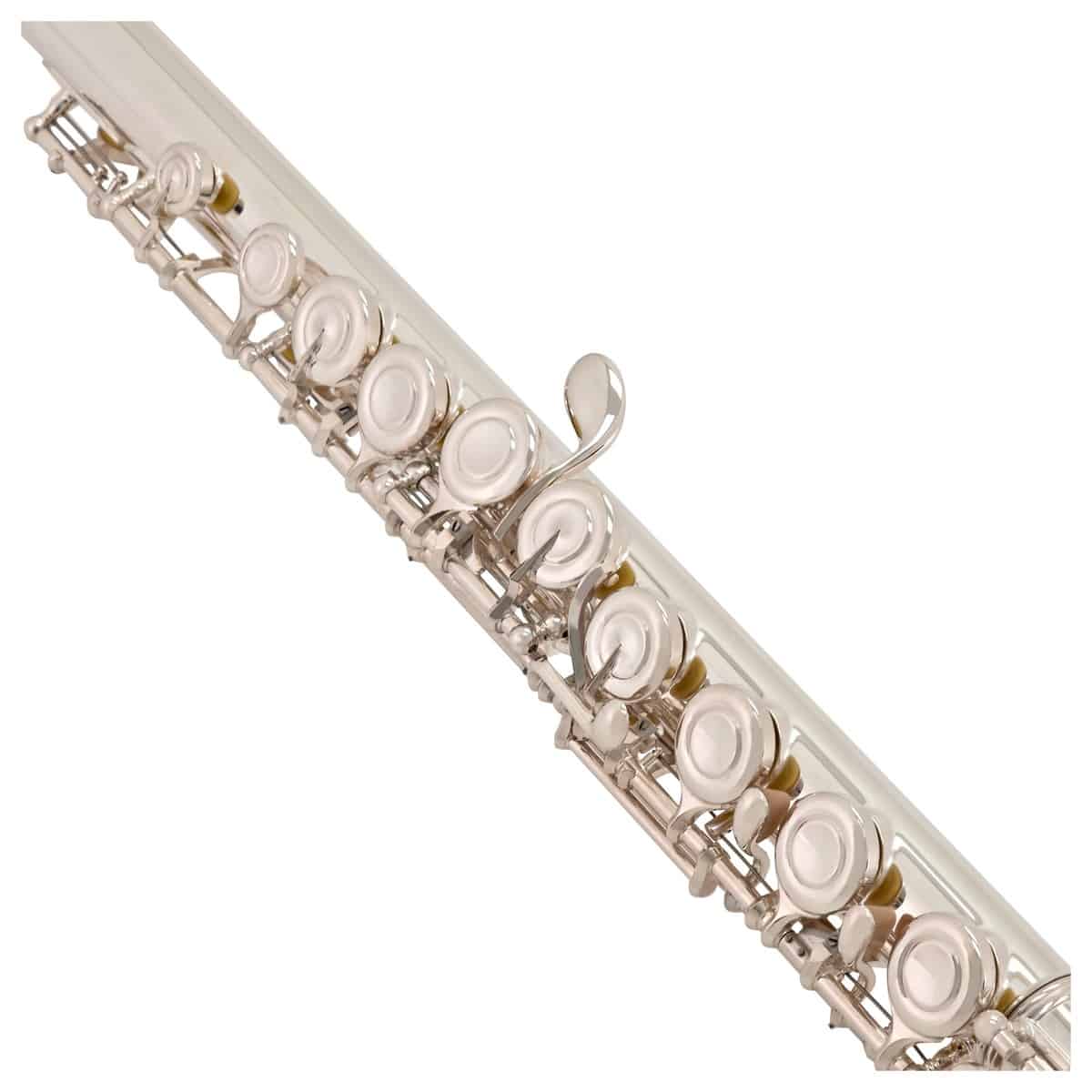
PRICE LEVEL: Intermediate
FEATURES: Silver plated throughout
Yamaha YFL212
When you check the price above, you’ll see there are loads of great places to buy this item. Our personal favorite is Gear4music.
It is the largest music retailer in the UK and fast becoming the most respected online music shop in the US too. Their customer service is excellent, they have competitive prices, really fast shipping, and usually have the longest guarantee.
Most professional musicians use Gear4music, so there is no reason why you shouldn’t too!
- Their popularity with teachers and students means that they hold their value well so they are always a sound investment.
- Yamaha is a trusted brand
- Includes a split E, C footjoint and an offset G key
- Available with both straight and curved headjoints for smaller players
- Expensive compared to other beginner flutes
The professional musician who wrote this article combined many things,
from the product build, manufacturer’s reputation through to feedback
from other users, to create our famous TedScore™.
Piccolo
The smallest member of the flute family is the piccolo. This means tiny in Italian. The piccolo is most at home in the orchestra and adds a magical sparkle to the sound of a full orchestra.
They are most often made from wood to give a more rounded sound to their high range. You can also find piccolos in marching bands.
Whenever I have the chance to play the piccolo, it feels exhilarating, with its bright and piercing sound cutting through the air.
The Yamaha Student Piccolo FC-100 is one of our top choices. It feels lightweight and comfortable to hold, with smooth key action and a bright, clear tone that makes it a joy to play.
Comparatively, the Yamaha Student Piccolo FC-100 stands out from its competitors due to its reliable build quality, consistent intonation, and ease of play, making it an ideal choice for beginners and students.
In contrast, some competitors may offer a wider range of features or a more diverse tonal palette, but the FC-100 excels in its simplicity and ease of use, making it a dependable option for those starting out on the piccolo.
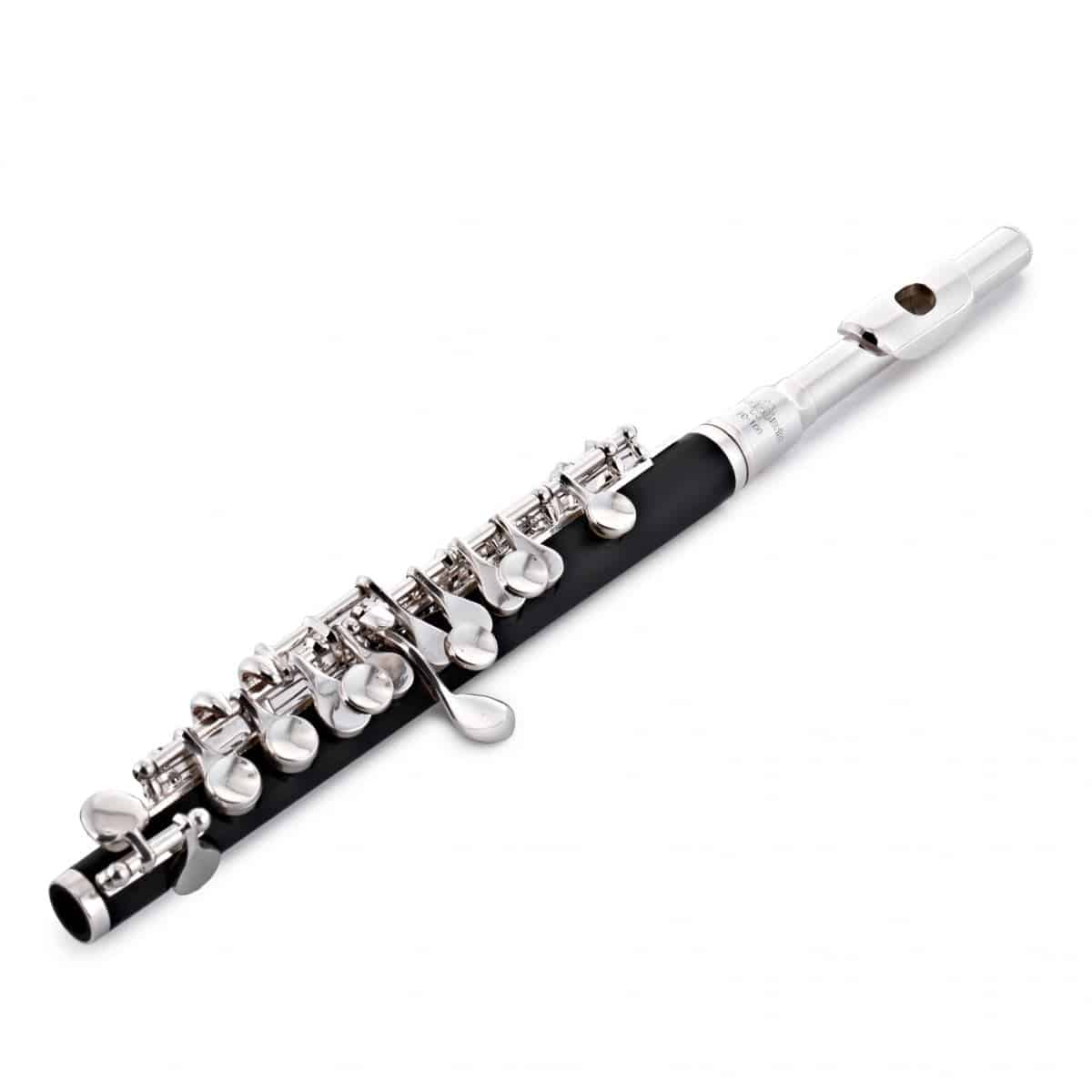
COMES WITH: An offset G Mechanism
FEATURES: Silver Plated ABS Body, a conical bore, and a hard case
Student Piccolo fc-100
When you check the price above, you’ll see there are loads of great places to buy this item. Our personal favorite is Gear4music.
It is the largest music retailer in the UK and fast becoming the most respected online music shop in the US too. Their customer service is excellent, they have competitive prices, really fast shipping, and usually have the longest guarantee.
Most professional musicians use Gear4music, so there is no reason why you shouldn’t too!
- Amazing Value For Money
- ABS Body Means It'll Withstand Regular Practice And Transport
- Conical Bore Means The Body's Tubing Gets Narrower Towards The Lower End, Resulting In An Even, Consistent Sound
- You'll Need To Upgrade To A More Expensive Instrument When You Progress Further
The professional musician who wrote this article combined many things,
from the product build, manufacturer’s reputation through to feedback
from other users, to create our famous TedScore™.


An alto flute is larger than a concert flute and plays in the key of G, so it is a transposing instrument. You will hear this flute played in famous orchestra pieces such as Ravel’s Daphnis et Chloe and Stravinsky’s Rite of Spring.

Alto & bass Flute
It is also featured in the score for Disney’s The Jungle Book. The alto flute represents the snake!
An even lower instrument is the bass flute. This instrument has to have a curved headjoint so the player can reach all the keys! It has a beautiful, mellow sound and can be heard in Holst’s The Planets Suite.
All of these instruments can be used in a flute choir which is a great ensemble to join.
But as the two most popular instruments are the concert flute and piccolo, I’ve created this little video to show the difference:

Anatomy of the flute
How Do I Put My Flute Together?
The flute is made up of 3 parts
- Head joint
- Body
- Foot Joint

The first thing you need to know is how to take your flute out of the box and put it together correctly. Pretty much all flutes come in 3 parts – the headjoint, the body and the footjoint. A good tip is to take 2 pieces at a time and gently wiggle them together. Most student flutes have markings to show you when the flute is lined up correctly.
How Do I Hold My Flute?
Whether you are left or right handed, you hold the flute the same way. Your flute should point out to your right hand side and your left hand should be closest to your head. All 10 fingers and thumbs are important to play the flute but most of the weight of the flute is supported by your right hand thumb and little finger and your left hand 1st finger.

Things to consider when buying a flute
A beginner’s flute is a perfect starting point for those interested in learning to play the instrument. It offers a smooth and easy playability, making it ideal for beginners. With its affordable price range and high-quality construction, it ensures a rewarding experience for flute enthusiasts at the entry level.
Let’s take a look at the things you should consider first before buying your flute.
Open or closed hole flute
For a beginner, a closed hole is the easiest flute to play because the holes are covered, making it easier to produce a clear sound. It’s also more suitable to that skill level. You may want to consider buying an open hole flute if you are interested in playing jazz or contemporary music using extended techniques. You can buy handy plugs to cover the holes whilst you get used to playing with an open hole flute, which is ideal for students.
A great sound effect on the flute is to slowly slide your finger across a tone hole or one of the open holes. This creates a gradual change of sound which is also called a glissando.
Material
Most beginner flutes are silver plated which offer good sound quality at an affordable price. There are also some plastic flutes on the market. These can be a good option for smaller players as they are a reduced size, lighter and more sturdy. However, you do sacrifice some sound quality.
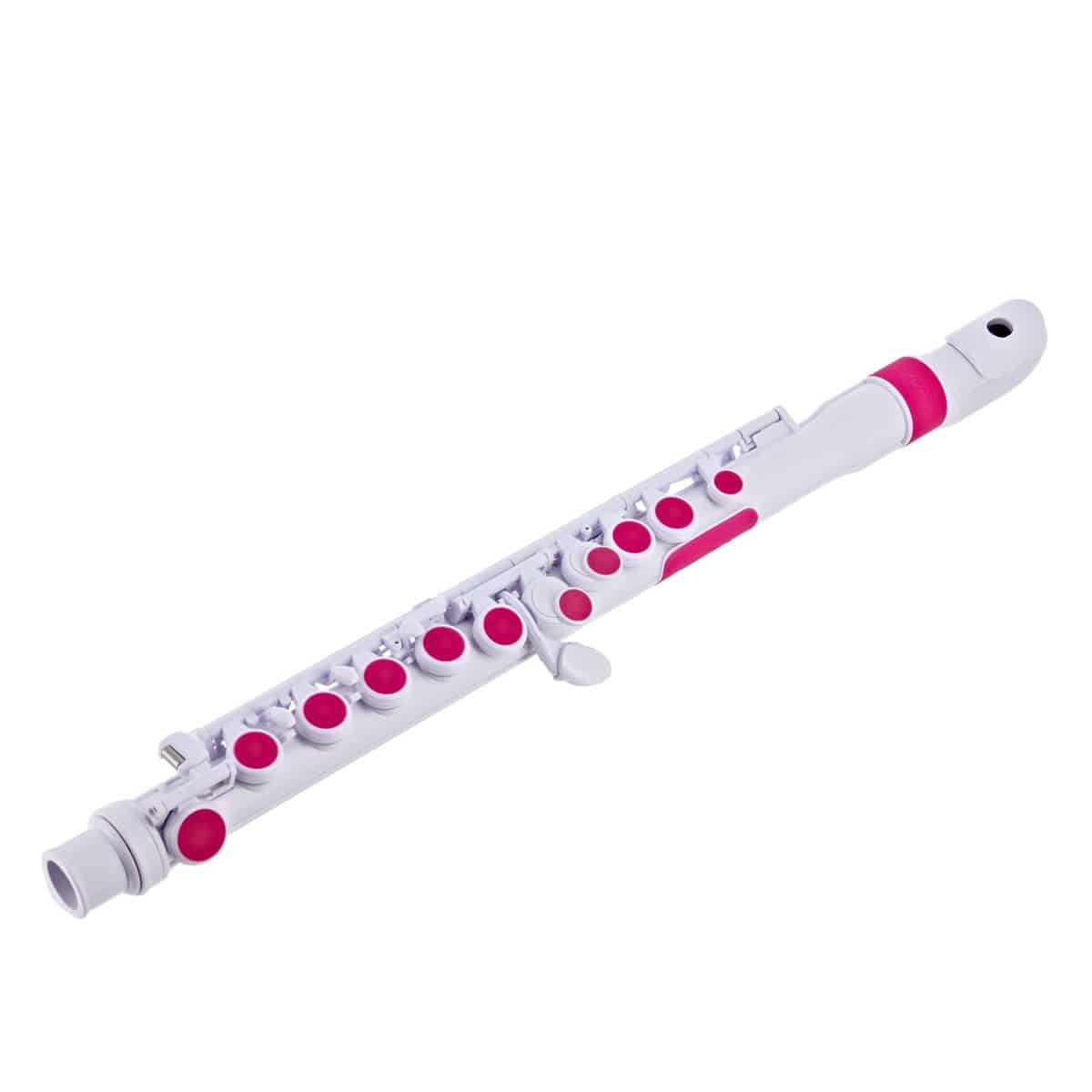
COMES WITH: A great case and cleaning kit
BEST THING: This instrument is super easy to clean and pretty indestructible!
Nuvo jFlute 2.0
When you check the price above, you’ll see there are loads of great places to buy this item. Our personal favorite is Gear4music.
It is the largest music retailer in the UK and fast becoming the most respected online music shop in the US too. Their customer service is excellent, they have competitive prices, really fast shipping, and usually have the longest guarantee.
Most professional musicians use Gear4music, so there is no reason why you shouldn’t too!
- The ‘donut’ headjoint makes it easier for small arms to reach all the keys.
- There are helpful grip spots to aid good hand position
- Extra “Firstnote’ mouthpiece which is very similar to a recorder mouthpiece.
- Great range of bright colours available.
- You lose some richness of sound that comes from a metal flute
The professional musician who wrote this article combined many things,
from the product build, manufacturer’s reputation through to feedback
from other users, to create our famous TedScore™.
The best flutes are made of precious metal. This offers the best sound quality, but they are also the most expensive. Flutes can be made out of solid silver, gold, platinum and even newer metals such as Palladium. Each of these metals has a different look as well as a different sound.
Some flute players prefer to buy a wooden flute. These can offer a softer and more mellow sound and can also look beautiful. If you are interested in baroque or folk music then this might be the material for you.
A good compromise for a mid-range flute is to buy a solid silver head joint with a silver-plated body. You can also change the sound of your flute with a wooden head joint. You will be amazed how much changing a head joint on a flute can affect the sound, it is also a great option to bear in mind if you want an upgrade but don’t want to replace your whole flute.
Quality of keys
Most student flutes have silver or nickel plated keywork. However, if you want to invest in a quality instrument then you will have the option of solid silver or gold keywork. This greatly improves the sound so is a great thing to look out for.
Very cheap flutes often have key work which is too soft so it bends easily. Avoid these flutes, because they are a bad investment that often cost a lot in repairs!
How much does a flute cost?
Flutes range massively in cost, from the price of a decent restaurant meal to the cost of a car! Watch this video to find out more:

B-foot or C-foot
Beginner flutes usually come with a “C” foot joint. This is all you need until you have been playing for quite a while.
A “B” foot joint gives you an extra low note which is a lovely addition for more advanced players. There are some pieces in solo and orchestral repertoire that require a B foot joint.
How to care for your flute
After every practice session you should clean your flute to remove any moisture that might have built up whilst you’ve been playing. You can use a cleaning cloth or gauze and your cleaning rod to remove moisture – or like me, use a ‘cleaning swab’ like this.

If you’re feeling extra keen then you can also polish the outside of your flute using a silver polishing cloth so give it the best shine. I like this cloth from Music Nomad.
You should also book your instrument in for a service with a qualified repairer every year or so. They will make sure your flute is adjusted correctly and replace any pads which have become too worn.
Your flute teacher or online forums will have recommendations for trusted repairers. Most woodwind shops also have an in house repairer. But if in doubt, join the Ted’s List VIP Facebook Group and ask the members who they can recommend.
I would warn you against trying to fix a flute yourself unless you really know what you’re doing. You should bear in mind that you make the problem worse, which will cost even more to fix!
Accessories for your flute
There is a huge series of products and accessories to choose from, because the flute is such a popular instrument. Here are the things you absolutely must have.
Case

COMES WITH: Water Resistant Design
FEATURES: Lightweight Material
Protec LX308 Pro Pac Lux Messenger Flute/Picc Case
When you check the price above, you’ll see there are loads of great places to buy this item. Our personal favorite is Gear4music.
It is the largest music retailer in the UK and fast becoming the most respected online music shop in the US too. Their customer service is excellent, they have competitive prices, really fast shipping, and usually have the longest guarantee.
Most professional musicians use Gear4music, so there is no reason why you shouldn’t too!
- Lots of pockets for all accessories
- Adjustable strap
- Looks smart and professional
- Quite bulky
- More expensive than smaller cases.
The professional musician who wrote this article combined many things,
from the product build, manufacturer’s reputation through to feedback
from other users, to create our famous TedScore™.
Your instrument needs a case for when you take it out of your house to rehearsals and lessons. A hard case is best as it protects your flute from damage and weather conditions.
Your instrument will normally come with a standard case, but you can also get great cases which include storage pockets for pencils and cleaning accessories.
You can also get cases which fit a flute and a piccolo, this can be useful if you need both for orchestra.
Instrument Stand
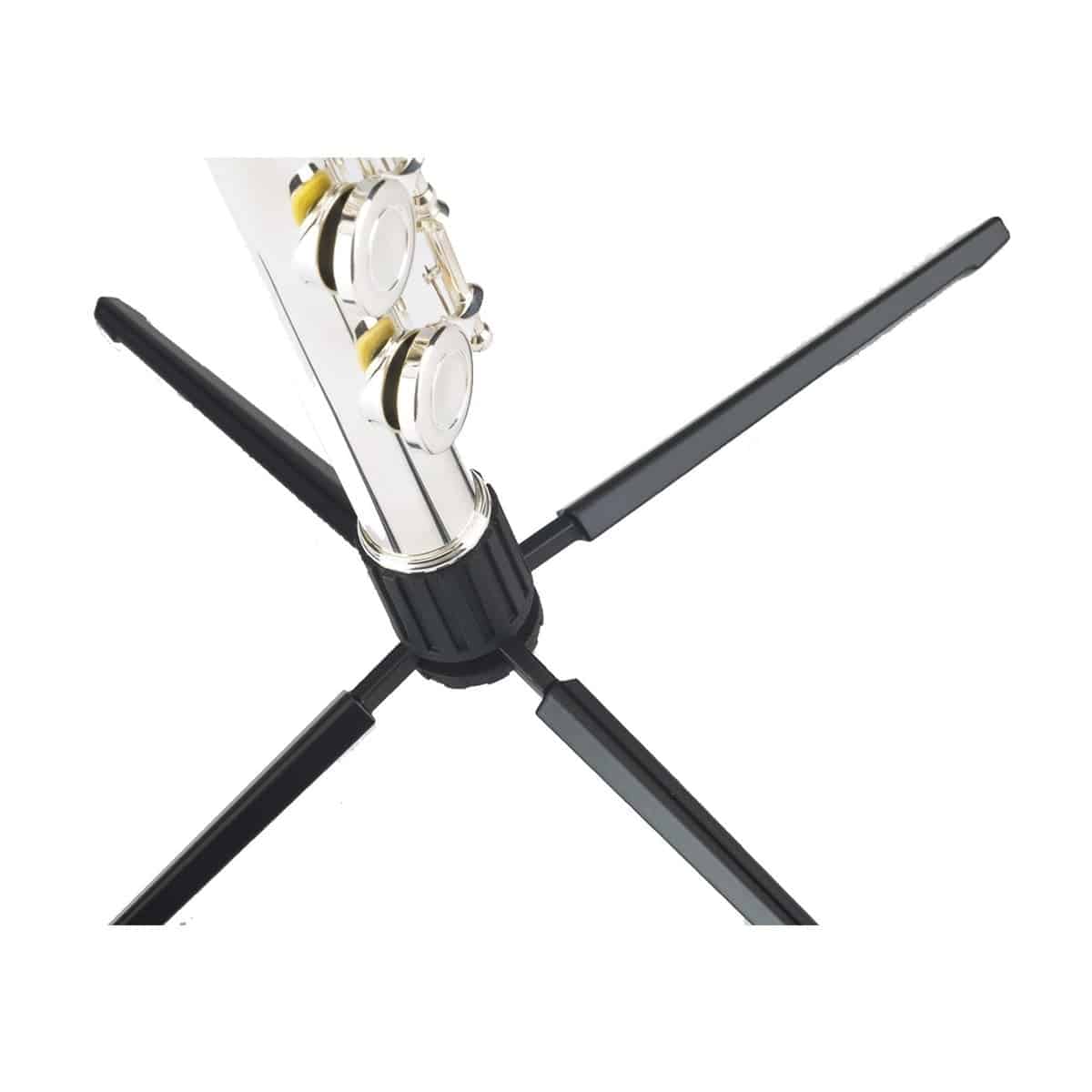
COMES WITH: Lightweight design
FEATURES: Soft plastic coating that won't scratch your instrument
K&M compact stand
When you check the price above, you’ll see there are loads of great places to buy this item. Our personal favorite is Gear4music.
It is the largest music retailer in the UK and fast becoming the most respected online music shop in the US too. Their customer service is excellent, they have competitive prices, really fast shipping, and usually have the longest guarantee.
Most professional musicians use Gear4music, so there is no reason why you shouldn’t too!
- It folds up so small it can even fit inside your foot joint in your case so it takes up no room at all in your bag!
- Smart, black colour, great for concerts
- Can feel a little flimsy.
The professional musician who wrote this article combined many things,
from the product build, manufacturer’s reputation through to feedback
from other users, to create our famous TedScore™.
A stand for your instrument is very important, because this keeps your flute safe whilst you are not using it. I always find I do much more practice if my instrument is already out of its case and on the stand in my room.
Somehow it seems easier to persuade yourself to practice!
I like this K&M compact stand above as it folds up so small it can even fit inside your foot joint in your case so it takes up no room at all in your bag!
If you are looking for something more sturdy, Hercules Stands are famous for being a very secure place for your instrument.
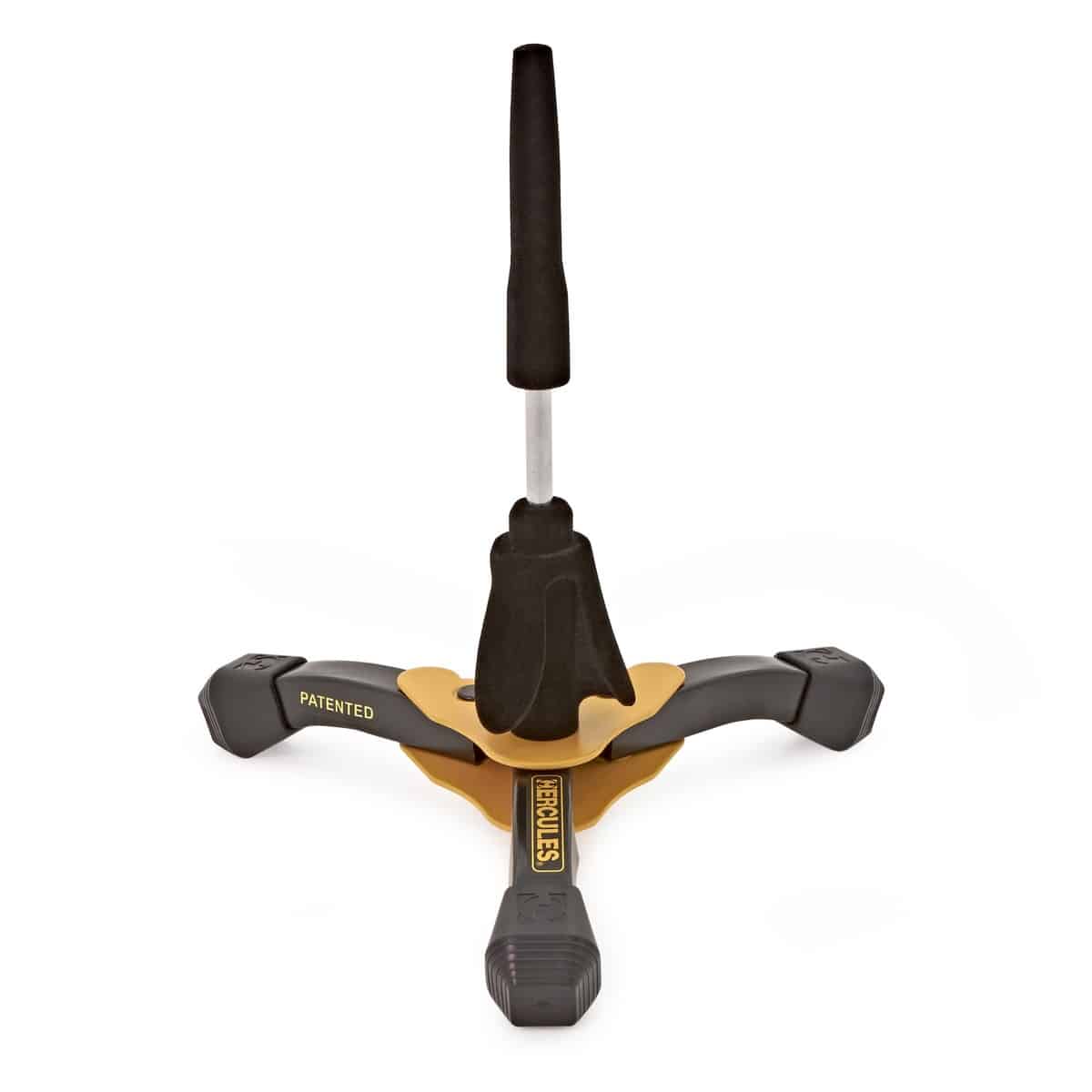
COMES WITH: A carry bag for convenience
PRICE LEVEL: Intermediate
Hercules Deluxe Flute/Clarinet Stand
When you check the price above, you’ll see there are loads of great places to buy this item. Our personal favorite is Gear4music.
It is the largest music retailer in the UK and fast becoming the most respected online music shop in the US too. Their customer service is excellent, they have competitive prices, really fast shipping, and usually have the longest guarantee.
Most professional musicians use Gear4music, so there is no reason why you shouldn’t too!
- Soft, velvet fabric to protect your flute
- Can also be used for a clarinet
- Folds up into carry bag
- Quite heavy!
The professional musician who wrote this article combined many things,
from the product build, manufacturer’s reputation through to feedback
from other users, to create our famous TedScore™.
Music Stand
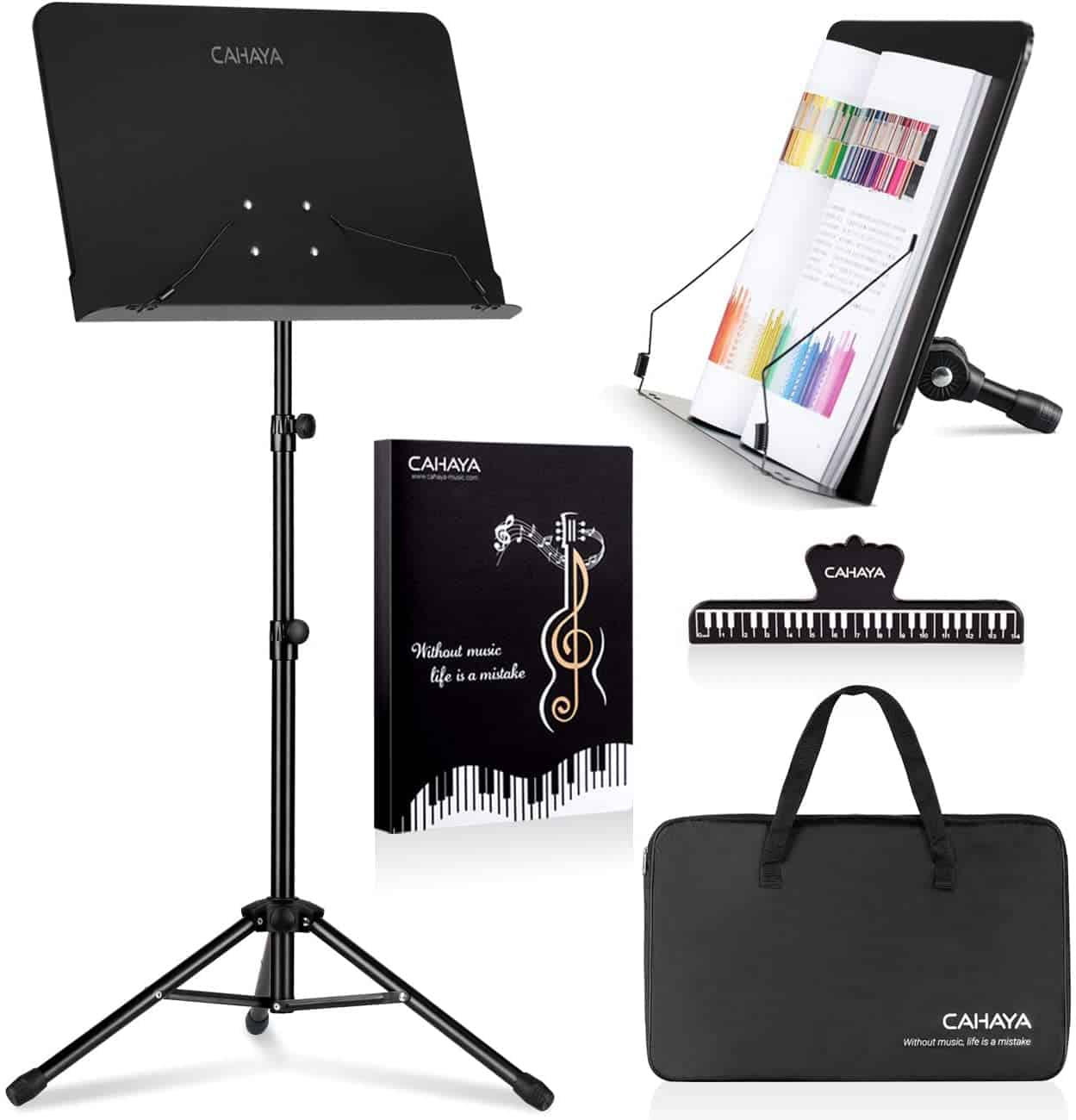
INCLUDES: Light | Carry Case | Sheet Music Clip
FEATURES: A carrying bag and a sheet music folder
Cahaya Portable Music Stand
When you check the price above, you’ll see there are loads of great places to buy this item. Our personal favorite is Gear4music.
It is the largest music retailer in the UK and fast becoming the most respected online music shop in the US too. Their customer service is excellent, they have competitive prices, really fast shipping, and usually have the longest guarantee.
Most professional musicians use Gear4music, so there is no reason why you shouldn’t too!
- Amazing complete kit
- Has everything you need
- Strong, yet transportable
- None!
The professional musician who wrote this article combined many things,
from the product build, manufacturer’s reputation through to feedback
from other users, to create our famous TedScore™.
A music stand is so important for all musicians for practice at home as this means you can play with the best possible posture. If you have your music balanced on a table or a chair then it is likely you will end up looking down instead of straight ahead. This will affect your sound and your breathing.
Luckily music stands are very affordable so there is no excuse to not have one. You can get a wide range of colours and styles.
Once you’ve bought your stand make sure you have it at the correct height. Your teacher can help you with this if you’re unsure.
How to tune your flute
Nobody likes an out of tune flute, so you should learn how to tune up correctly for everyone’s sake.
Most ensembles tune to an “A”, so play this note and listen carefully against a piano, oboe or electronic tuner.
You adjust your headjoint to find your tuning. Pulling the headjoint out a centimetre or so will make the flute flatter as the instrument becomes longer – so do this if your tuner or your teacher says you are sharp.
If you are flat then push your headjoint in a bit. If you can’t push in anymore then try blowing air down your instrument. Your instrument might just be a little cold so warm it up with your air and then try again.
If you are finding it hard to play in tune then check your embouchure hole position on your lip. Your lip plate should sit right in the middle of your bottom lip with the hole in the headjoint pointing up to the ceiling.
It might take a bit of experimenting to find the perfect spot as tiny adjustments can make a big difference to your sound.
In addition, a beginner flute’s range typically spans from C4 to C7. This range covers three octaves and is suitable for learning and practicing basic melodies and scales. As beginners progress, they can explore higher notes and more complex musical pieces.
Flute for beginners
Summary
Beginners flute in English is an ideal choice for those starting their musical journey. This versatile instrument offers a smooth learning experience with its ergonomic design and user-friendly features.
We hope this guide to flute for beginners has been helpful, and given you a real insight into this wonderful instrument.
Flutes are a budget friendly woodwind instrument and a great instrument for children to learn. You can make a lovely, soft sound and can play scales with ease. What are you waiting for? Start playing the flute today!
Nina Barwell
Young flautists need a good teacher, since it is so easy to learn bad habits. No flautists make progress without daily practice. It is so much fun to learn to get a good tone and good technique because this opens doors to play in many groups. To become inspired, young players should listen to recordings of great flautists.
FAQ's
If you are willing to invest in a great quality beginner flute then I would recommend the Pearl 505E Quantz. Yamaha student flutes are also a great investment and are known for their high quality. For small beginners you will need to buy a curved headjoint or a Nuvo plastic flute, because these are designed especially for smaller players.
If you practice then yes! The hardest bit is learning to make a sound as a flutist, if you play every day you will soon find a great sound. You will be whizzing up and down your scales before you know it!
I would recommend hiring a teacher, because it’s easy to develop bad habits if you teach yourself, which can be a problem. There are many teachers who offer online lessons, which is great if you don’t want to travel for lessons.
This is a tricky question because I have never played the violin. I would say that both instruments are probably a similar level of difficulty, but in different ways, so it’s worth trying both if you can’t decide.
See which one you find most natural! For children it is great to see which one they are drawn to, because they sound very different from one another.
While it is possible to learn some basic flute techniques in a month, becoming proficient at playing the flute takes time and consistent practice over a longer period of time. It is important to have realistic expectations and be willing to invest the necessary time and effort to develop your skills.
To play a pan flute, hold the instrument vertically and blow across the top of the tubes to produce sound. Covering and uncovering the holes on the tubes with your fingers will change the pitch of the notes.











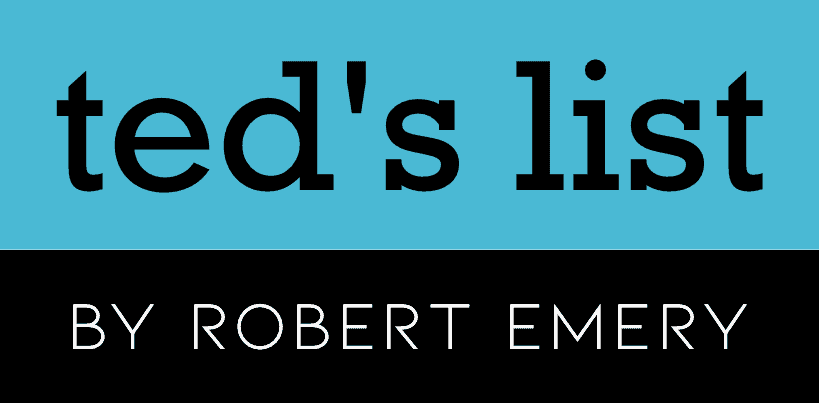
I think there’s a lot more to consider when talking about open vs closed hole flutes than what’s mentioned. Open hole flutes offer more control and are preferred for their expressiveness, but they’re definitely not for beginners. Wondering if anyone else has thought about how this choice affects a player’s progression and technique over time.
This guide is super cool! Learned a lot about different types of flutes that I didn’t know before. Really makes me appreciate my concert flute more. Plus, the buying tips are gold for someone who’s looking to upgrade soon. Thanks, Chloë Vincent, for putting this together!
Glad to see young musicians eager to learn. Keep up the passion, flute_nerd123!
Ah, the anatomy of a flute. Finally, I can dismantle mine and actually have a clue how to put it back together. Was about to turn it into an expensive wall decor.
Just got my first flute, and I’m kinda unsure about the difference between B-foot or C-foot. Does it affect the sound a lot?
Beginning with the Flute was an adventure but I can finally say that I am good enough to play a few notes! Extremely proud!
Well done Maxine. Keep up the good work!